A Guide to Choosing the Right Cable Tray Accessories in the UAE
In the high-stakes world of UAE infrastructure—from cutting-edge data centers in Dubai to massive industrial plants in Abu Dhabi—managing cables goes far beyond simple organization. It's about building a foundation for safety and unwavering reliability. This guide focuses on the unsung heroes of electrical installations: cable tray accessories. These are the crucial components that stand between a smooth-running system and a catastrophic failure, especially when dealing with the region's unique challenges like extreme heat, humidity, and dust.
Building a Reliable Cable Management System for GCC Projects
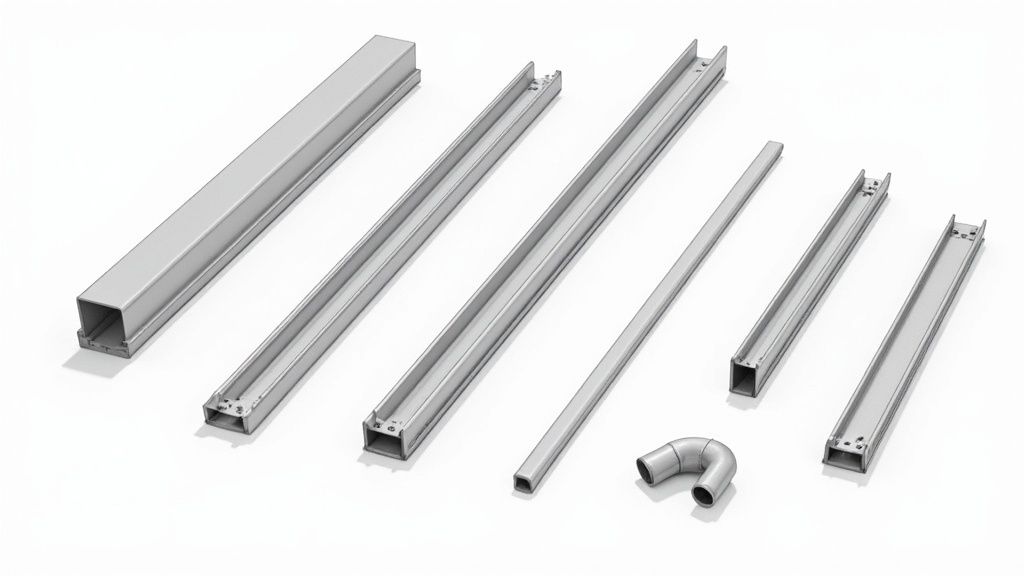
For any engineer, panel builder, or procurement team working across the UAE and GCC, a solid cable management system is the backbone of a successful electrical project. It’s a critical mistake to view cable tray accessories as minor add-ons. In truth, they are the fundamental building blocks that determine the system's structural integrity, safety, and long-term performance in demanding local conditions.
These accessories—couplers, bends, risers, and supports—do much more than connect tray sections. They create the engineered framework needed to navigate complex building layouts, handle heavy cable loads without sagging, and shield essential wiring from environmental damage. Without the right accessories, a cable tray is just a metal channel. With them, it becomes a complete, engineered pathway designed for resilience.
The Growing Demand in the GCC
The critical nature of these components is reflected in their booming market growth. This trend is no surprise, given the massive infrastructure development happening across the region, from Dubai's ambitious smart city projects to the sprawling industrial expansions in Saudi Arabia. This rapid development demands electrical systems that can be trusted to perform without fail.
The Middle East and Africa's cable management market was valued at USD 946.37 million in 2023 and is projected to hit USD 1.81 billion by 2032. This explosive growth underscores the region's investment in quality infrastructure where dependable cable support systems are non-negotiable. You can read the full analysis on this market growth for a deeper look at its regional impact.
Why Quality Accessories Matter in the UAE's Climate
In the punishing climate of the Gulf, skimping on quality or using mismatched accessories is a recipe for disaster. High ambient temperatures can cause cables to sag, putting immense stress on connections, while pervasive dust and humidity accelerate corrosion. Using a complete, unified system from a trusted supplier like GoSwitchgear ensures you avoid these problems.
Here’s why a solution-focused approach is critical:
- Structural Integrity: When components are designed to work together, their load capacities and connection security are certified, providing confidence in system performance.
- Safety and Compliance: Using correct, certified accessories is essential for proper earthing and bonding, ensuring compliance with strict local regulations from authorities like DEWA or ADDC.
- Longevity: High-quality materials and finishes, like hot-dip galvanizing (HDG), are built to resist corrosion and degradation, maximizing the system's lifespan and ROI.
Ultimately, investing in the right cable tray accessories is an investment in the safety and operational continuity of your entire facility. It’s how you ensure your electrical network isn't just tidy, but tough enough for any project in Dubai, Abu Dhabi, or the wider GCC.
Understanding the Anatomy of a Cable Tray System
Think of a cable tray system as the skeleton for your building’s electrical network. If the straight tray sections are the bones, then the cable tray accessories are the crucial joints and connectors that give the entire structure its strength, flexibility, and direction. Without these components, you have a pile of metal parts, not a functional system that can safely route cables through a complex site.
A properly engineered system is an integrated framework. Using mismatched or low-quality accessories compromises the integrity of the whole assembly. Let's break down the essential components that bring a professional cable management solution to life.
The Core Building Blocks of a Tray System
To appreciate their value, it's vital to understand the specific role each accessory plays. For any electrician or panel builder in the UAE, selecting the right part is non-negotiable for a safe, compliant, and efficient installation. These components are purpose-built to solve specific routing and structural challenges on-site.
Here’s a look at the key players:
- Couplers and Connectors: These are the most fundamental accessories. A coupler's primary function is to securely join two straight sections of cable tray, ensuring both mechanical strength and electrical continuity for proper earthing. Using manufacturer-approved couplers from suppliers like GoSwitchgear guarantees a perfect fit, preventing weak spots.
- Bends (Horizontal and Vertical): Buildings are never just straight lines. Bends allow the tray system to navigate corners and obstacles smoothly. A system without proper bends creates stress points and can damage cables. Horizontal bends change direction on the same level, while vertical bends (risers) allow the tray to move between different elevations.
- Tees and Crosses: These fittings are essential for creating junctions, allowing cable routes to branch off from a main run. A 'Tee' creates a single branch, while a 'Cross' allows for branches in two opposite directions, commonly seen in complex layouts like data centers or large industrial facilities in the GCC.
- Reducers: Not all cable runs require the same capacity. Reducers provide a smooth transition from a wider tray to a narrower one as the cable count changes. This optimizes the system, saving space and cost.
This quick reference table outlines what each primary accessory does and its common application in the UAE/GCC region.
Essential Cable Tray Accessories and Their Functions
| Accessory Type | Primary Function | Common Application Scenario |
|---|---|---|
| Couplers | Securely joins two straight tray sections | Extending a long, straight run of cable tray down a corridor in a commercial tower. |
| Horizontal Bends | Changes the direction of the tray on a flat plane (e.g., 90-degree turn) | Navigating around a building corner or a large support column in a warehouse. |
| Vertical Bends (Risers) | Changes the elevation of the tray system, moving it up or down | Running cables from a ceiling-level tray down to a wall-mounted panel in a plant room. |
| Tees & Crosses | Creates branching points for cables to diverge from the main path | Distributing power and data from a central trunk to individual server racks in a data center. |
| Reducers | Transitions from a wider cable tray to a narrower one | Tapering down the main tray as fewer cables are needed further from the electrical room. |
| Covers | Protects cables from dust, debris, moisture, and physical impact | Outdoor installations or in dusty industrial environments across the UAE to shield cables. |
| Dividers | Separates different types of cables within the same tray | Keeping power cables separate from sensitive data cables to prevent electromagnetic interference (EMI). |
Understanding these functions helps ensure every part of your cable tray system is specified correctly, creating a robust and reliable electrical backbone.
The infographic below shows how these accessories come together to create a system that isn’t just organized, but also safer and ready for future expansion.
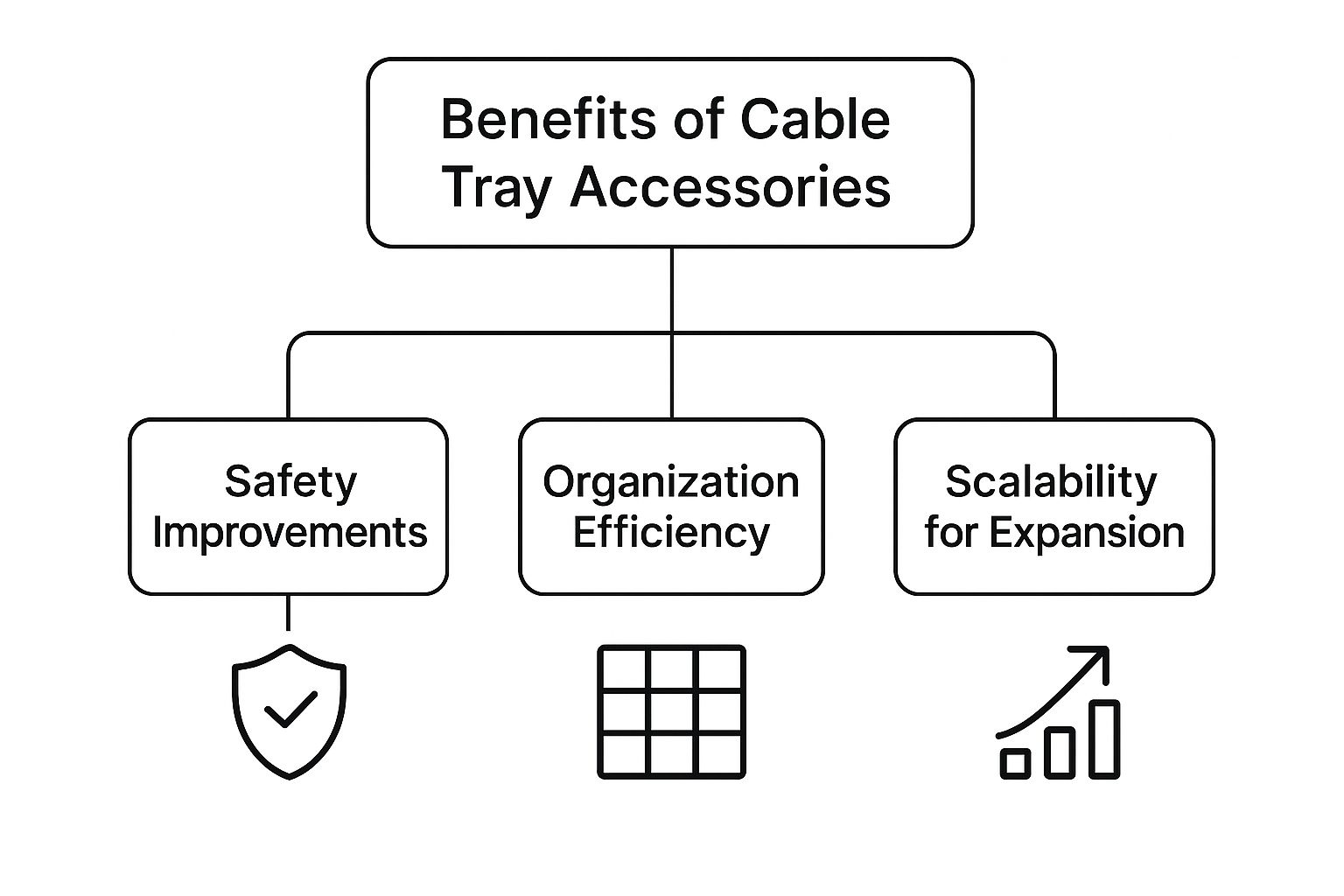
As you can see, the benefits go far beyond just routing cables. It’s about building a safe, adaptable electrical infrastructure that will last.
Support and Protection Components
Beyond guiding the path, other accessories are vital for providing structural support and protecting cables—a major concern in busy industrial sites across Dubai and Abu Dhabi.
A cable tray system's reliability is only as strong as its weakest link. Proper support spacing and the use of correct fastening hardware are not just best practices; they are fundamental requirements for ensuring the system can handle its specified load capacity without failure.
Supports, hangers, and clamps are the workhorse components that physically attach the tray system to walls, ceilings, or floor-standing structures. Calculating the correct support spacing based on the tray type and cable weight is critical for preventing sagging, which can put immense strain on both cables and connections.
Finally, covers and dividers add another crucial layer of functionality.
- Covers are absolutely essential in the dusty GCC environment. They protect cables from debris, moisture, and accidental physical impact.
- Dividers are metal barriers installed inside the tray to separate power and data cables. This separation is crucial for preventing electromagnetic interference (EMI), which can disrupt sensitive communication signals.
By understanding the distinct role of each accessory, engineers and procurement teams can design systems that are compliant and suited to their project's unique demands. Sourcing a complete range of these components from a single, reliable supplier like GoSwitchgear ensures compatibility and certified performance.
Selecting Accessories For UAE Climate And Project Demands
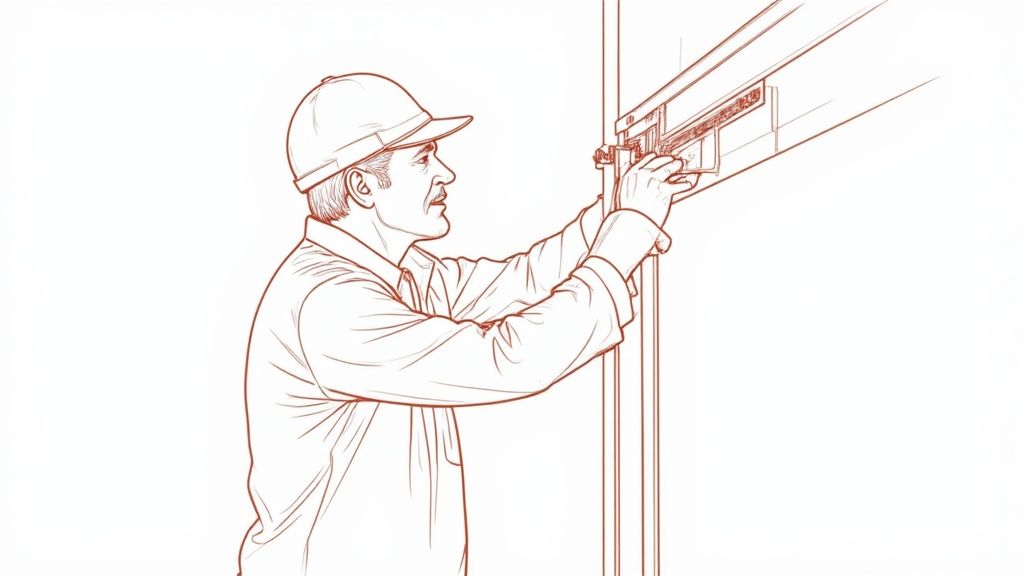
Choosing the right cable tray accessories in the UAE and wider GCC region isn't just about fit; it's about survival. For any engineer or procurement team, the decision must go beyond basic dimensions to account for the punishing local environment. An incorrect choice leads to premature system failure, safety hazards, and unexpected costs. A solid selection process focused on material resilience, load capacity, and compliance is the only way to build electrical infrastructure that lasts in Dubai, Abu Dhabi, or Saudi Arabia.
Material Finishes For GCC-Specific Challenges
The first line of defense against the Gulf's aggressive climate is the material finish. The combination of high humidity in coastal cities like Dubai and high ambient heat creates a perfect storm for accelerated corrosion. This makes the choice of finish a critical decision that directly impacts system longevity.
- Hot-Dip Galvanized (HDG) Steel: This is the go-to standard for most outdoor and industrial projects across the UAE. The process involves dipping the steel accessory in molten zinc, creating a thick, durable barrier against moisture and salt. It offers the best balance of cost and long-term corrosion resistance.
- Stainless Steel (SS 316): For the harshest environments—such as marine terminals, offshore rigs, or chemical plants—SS 316 is the superior choice. Its molybdenum content provides exceptional resistance to chlorides and other corrosive agents.
- Pre-Galvanized Steel: This finish is best suited for indoor, climate-controlled spaces like commercial towers or data centers, where high humidity and contaminants are not a major threat.
Matching Accessories To Tray Types And Load Demands
After selecting your material, you must ensure the accessory's design matches both the cable tray type and its load. Any mismatch compromises the system's structural integrity. For example, using light-duty couplers on a heavy-duty ladder tray with armored cables is a recipe for failure. You must match the accessory's specifications to the system's real-world demands to ensure every bend, tee, and support can handle the mechanical stress.
Compatibility is also key. A coupler designed for a perforated tray will not work correctly with a wire mesh system.
When specifying components, always remember: the load capacity of your entire system is only as strong as its weakest link. A high-capacity tray is useless if the supports or connectors can't handle the same load.
Ensuring Compliance And Protection
Finally, compliance is non-negotiable. Both international and local standards must be met. Always look for accessories that adhere to IEC and NEMA standards, a fundamental requirement for most projects throughout the GCC.
Equally important is the Ingress Protection (IP) rating, especially for tray covers. The dusty conditions in the UAE mean an IP-rated cover is crucial for protecting sensitive cables from dust and moisture, which can degrade cable performance and introduce safety risks. This holistic approach, from tray selection to termination—where understanding the role of cable lugs in control panel systems is also vital—ensures a truly reliable system.
Best Practices For Flawless Accessory Installation
Even the highest quality components can fail if the installation is substandard. A flawless installation is about building a system that is structurally sound, electrically safe, and ready to perform reliably for decades. For electricians and installation crews on job sites across the UAE, adhering to best practices is what separates a professional, long-lasting setup from one plagued by problems and rework. This section provides actionable, on-the-ground advice for installing cable tray accessories correctly.
How to Install: Correct Torque And Secure Fastening
One of the most critical installation mistakes is improper torque on fasteners. It's a common error to either under-tighten or over-tighten connections.
- Under-tightening creates loose couplers and supports, which can cause sections to sag or pull apart under load—a major safety hazard.
- Over-tightening can strip threads, deform the accessory, or crack the protective galvanized coating, inviting corrosion.
Installation Tip: Always use a calibrated torque wrench and follow the manufacturer's specified torque settings for every fastener. This ensures a rock-solid mechanical connection without weakening the material, which is vital for structural performance in tough industrial environments.
Ensuring Perfect Coupler Alignment
Couplers are the backbone connecting straight tray sections. Their alignment is non-negotiable for structural strength and electrical continuity. Misaligned couplers create weak points, concentrating stress and increasing the risk of failure. Perfect alignment distributes the load evenly and guarantees solid metal-to-metal contact, essential for properly earthing the entire tray system according to local safety regulations.
Common Installation Mistakes to Avoid in the GCC
- Using Mismatched Hardware: Never mix accessories from different manufacturers. Minor differences in dimensions or materials can compromise the entire system's integrity.
- Improper Earthing and Bonding: Failing to correctly earth the cable tray system is a serious safety violation. Ensure all sections are electrically continuous and properly connected to the building's main earthing terminal.
- Cutting and Modifying on Site: Field modifications must be done right. All cut edges must be completely deburred and treated with a zinc-rich coating to prevent corrosion.
- Overloading the Tray: Adhere strictly to the calculated cable fill and weight limits. Overloading a tray is a direct route to structural failure. This requires careful planning, factoring in all system components, such as a Capacitor Duty Contactor, to manage the overall electrical load.
- Ignoring Expansion and Contraction: In the UAE's climate, metal expands and contracts. Use expansion couplers on long, straight runs to prevent the system from buckling under thermal stress.
A firm commitment to quality installation, backed by reliable components from GoSwitchgear, is the final piece of the puzzle for a dependable and safe cable management infrastructure.
Maintenance Best Practices: A Long-Term Maintenance Schedule
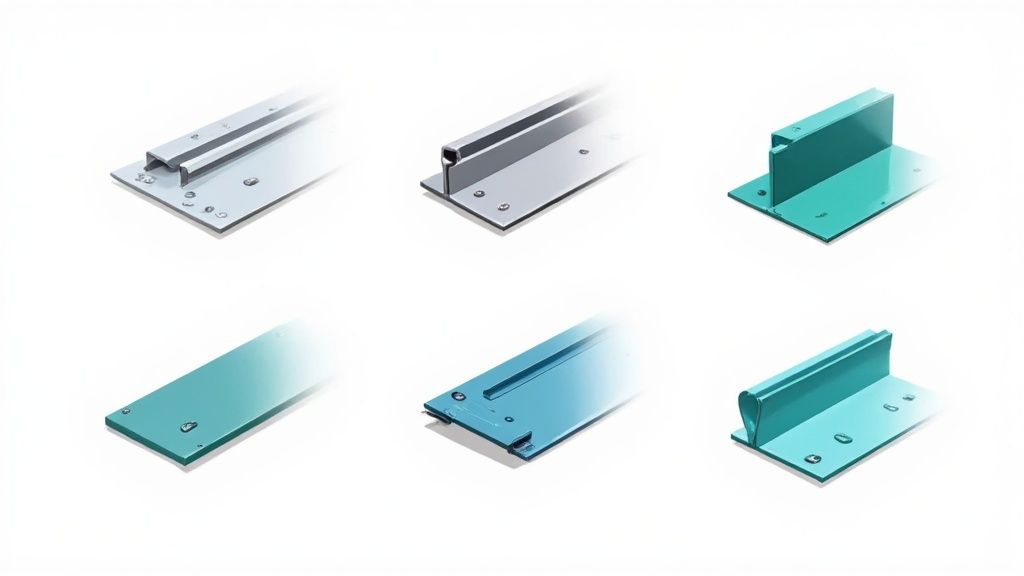
A common oversight is assuming the job is done once the system is energized. In the demanding climates of the UAE and GCC—where heat, dust, and humidity are relentless—proactive maintenance of your cable tray accessories is essential for long-term performance, safety, and reliability. Ignoring routine checks can lead to slow degradation, sudden failures, and costly downtime. A smart maintenance strategy with regular inspections protects your initial investment.
The global demand for cable trays is rising. After a brief slowdown, the Middle East market has rebounded, fueled by government-led construction in sectors from oil & gas to data centers. You can get more details on this global market trend and its regional significance.
A Practical Inspection Schedule For GCC Conditions
A structured maintenance plan is your best defense against the elements. For most sites in Dubai or Abu Dhabi, a bi-annual inspection (every six months) is sufficient. However, for harsh environments like coastal areas or heavy industrial zones, quarterly inspections are advisable.
Your inspection checklist should include:
- Visual Check for Corrosion: Inspect all accessories, paying close attention to couplers, fasteners, and any spots where the coating might be damaged. Look for any signs of rust or wear.
- Verify Fastener Tightness: Temperature swings can loosen hardware. Check the tightness of nuts and bolts on all couplers and support hangers.
- Assess for Physical Damage: Scan for any signs of bending, warping, or impact damage, especially in high-traffic areas.
- Inspect for Overloading: Check if new cables have been added. Ensure the tray's fill capacity is not exceeded and that the new weight isn't causing sag.
Corrective Actions And Safety Protocols
Knowing how to fix a problem safely and effectively is critical.
The goal of maintenance is to keep the system performing as designed. This includes preserving its electrical continuity, which is non-negotiable for fault protection and personnel safety.
For minor issues like a loose bolt, tighten it to the manufacturer’s torque specifications. If you find early-stage corrosion on a galvanized surface, clean it and apply a cold zinc galvanizing spray to restore protection.
A critical safety check is verifying earth and bonding continuity. Use a multimeter to confirm a low-resistance path from the furthest point of the tray system back to the main earthing terminal. A broken path is a serious safety hazard and must be fixed immediately by a qualified electrician.
Your Partner for Cable Management Success in Dubai and Abu Dhabi
Building a robust electrical system requires a systematic approach where every component matters. As this guide has shown, high-quality cable tray accessories are the foundation of a safe, compliant, and durable installation, especially in the demanding environments of the UAE and across the GCC.
When planning your next project—whether in Dubai, Abu Dhabi, or anywhere else in the Gulf—the integrity of your system should not be left to chance. Success lies in partnering with a supplier who understands the local landscape, from climate challenges to specific regulatory requirements.
Let's Build Reliable Infrastructure Together
At GoSwitchgear, we invite engineers, contractors, and procurement managers to connect with our expert team. We provide project-specific quotes, in-depth technical consultations, and access to a massive inventory of accessories engineered for the region. You can see our complete range of Kable Konnect cable accessories to find exactly what your project demands.
Of course, in the competitive construction sector, having the right products is only half the battle. For businesses aiming to stand out, understanding effective construction marketing strategies can be the key to turning expertise into market leadership.
By prioritizing quality at every stage—from selection and installation to long-term maintenance—you're not just building a cable management system. You are building confidence and ensuring the operational reliability of your entire facility for years to come.
We are committed to arming your projects with the components and expertise needed to achieve excellence. Contact our team in Dubai for project support and let's discuss how we can support your next installation.
Frequently Asked Questions
Here are answers to common questions we receive from engineers, electricians, and procurement teams on projects across the UAE and GCC about selecting the right cable tray accessories.
What Is the Best Material for Cable Tray Accessories in Coastal UAE Areas?
For coastal areas like Dubai or Abu Dhabi, where you fight a constant battle against humidity and salt, your best choices are Hot-Dip Galvanized (HDG) steel or Stainless Steel (SS 316).
HDG is a robust material coated with a thick layer of zinc that acts as a durable shield against corrosion. For more demanding environments with potential chemical exposure, upgrading to Stainless Steel 316 offers superior protection and ensures maximum system lifespan, preventing costly, premature failures.
Do I Need Covers on All My Cable Trays?
While not mandatory for every tray, using covers is a smart, solution-focused practice for most installations in the GCC. Covers protect cables from key regional challenges:
- Dust Accumulation: Pervasive dust in the UAE can build up and degrade cable insulation over time.
- Direct Sun Exposure: Covers block UV radiation that can make cable jackets brittle.
- Accidental Impact: In busy industrial settings, a cover is a crucial safety measure against physical damage.
For data cables, covers provide extra shielding from electrical interference, ensuring signal integrity. Ensure you select a cover with the appropriate IP rating for the required level of protection.
Can I Mix Cable Tray Accessories From Different Manufacturers?
We receive this question frequently, and our professional advice is a firm no. It may seem like a cost-saving measure, but it is a recipe for long-term problems.
Using accessories from a single, unified system isn't just about convenience. It's about guaranteeing certified load ratings, ensuring proper electrical bonding for safety, and staying fully compliant with local UAE and GCC regulations.
Even minor differences in dimensions, locking mechanisms, or material grade can compromise the structural integrity of your system, leading to weak spots, sagging, and serious safety risks. Sticking with one manufacturer like GoSwitchgear ensures every component fits and performs as tested and certified.
For a complete, certified system of cable trays and accessories designed for the unique demands of the UAE and GCC, explore the solutions from GoSwitchgear. Find all the compatible components you need for your next project.


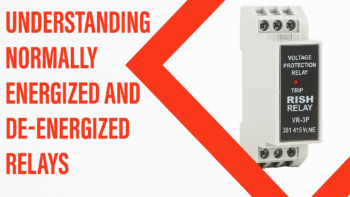
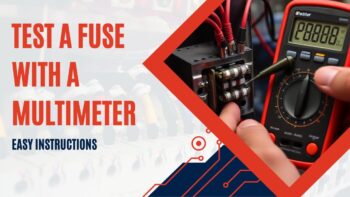

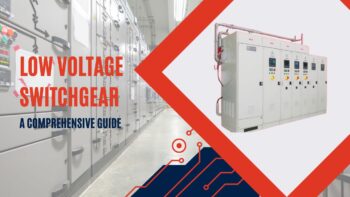

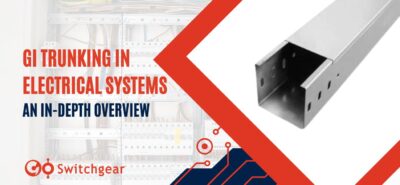

Leave a Reply